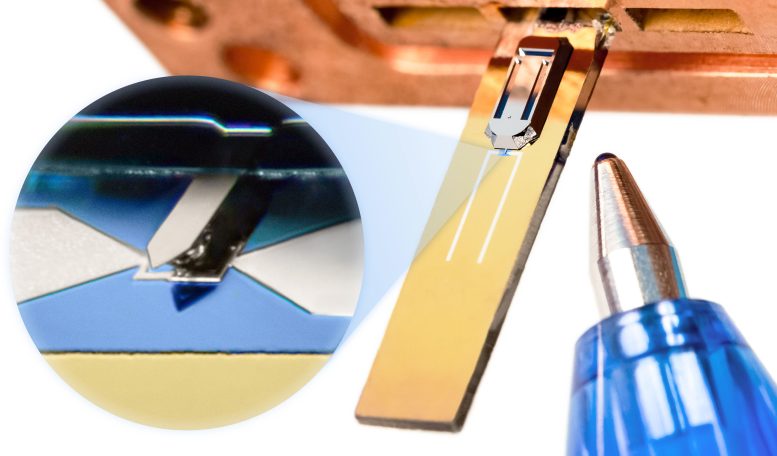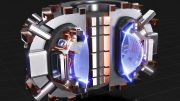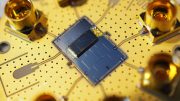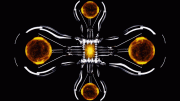
Superconducting circuit (white) on a silicon substrate fixed in a copper holder. The chip (silver) with the micromechanical oscillator is attached to the silicon substrate. The close-up shows the SQUID in the center of the circuit and directly above it the micromechanical oscillator with a magnet on its underside. A ballpoint pen serves as a size reference. Credit: IQOQI Innsbruck
Enhancing accessibility to the quantum properties of macroscopic objects.
Through optomechanical experiments, scientists aim to delve into the boundaries of the quantum realm and lay the groundwork for the creation of highly sensitive quantum sensors. In these experiments, everyday visible objects are coupled to superconducting circuits through electromagnetic fields.
To produce functional superconductors, these experiments are conducted inside cryostats at a temperature of around 100 millikelvins. However, this is still far from low enough to truly enter the quantum world. In order to observe quantum effects on large-scale objects, they must be cooled to nearly absolute zero through advanced cooling techniques.
Physicists led by Gerhard Kirchmair from the Department of Experimental Physics at the University of Innsbruck and the Institute of Quantum Optics and Quantum Information (IQOQI) have now demonstrated a nonlinear cooling mechanism with which even massive objects can be cooled well.
Cooling capacity higher than common
In the experiment, the Innsbruck researchers couple the mechanical object – in their case a vibrating beam – to the superconducting circuit via a magnetic field. To do this, they attached a magnet to the beam, which is about 100 micrometers long. When the magnet moves, it changes the magnetic flux through the circuit, the heart of which is a so-called SQUID, a superconducting quantum interference device.
Its resonant frequency changes depending on the magnetic flux, which is measured using microwave signals. In this way, the micromechanical oscillator can be cooled to near the quantum mechanical ground state.
Furthermore, David Zöpfl from Gerhard Kirchmair’s team explains, “The change in the resonant frequency of the SQUID circuit as a function of microwave power is not linear. As a consequence, we can cool the massive object by an order of magnitude more for the same power.” This new, simple method is particularly interesting for cooling more massive mechanical objects. Zöpfl and Kirchmair are confident that this could be the foundation for the search for quantum properties in larger macroscopic objects.
Reference: “Kerr Enhanced Backaction Cooling in Magnetomechanics” by D. Zoepfl, M. L. Juan, N. Diaz-Naufal, C. M. F. Schneider, L. F. Deeg, A. Sharafiev, A. Metelmann and G. Kirchmair, 17 January 2023, Physical Review Letters.
DOI: 10.1103/PhysRevLett.130.033601
The study was funded by the Austrian Science Fund FWF and the European Union, among others. Co-authors Christian Schneider and Lukas Deeg are or were members of the FWF Doctoral Program Atoms, Light, and Molecules (DK-ALM).









Be the first to comment on "A Blast Chiller for the Quantum World"